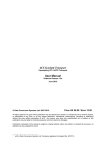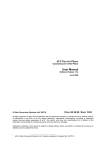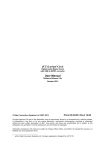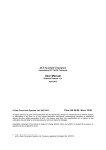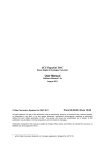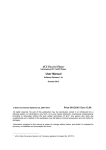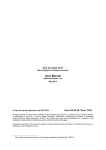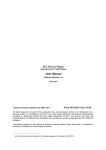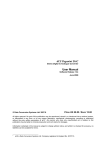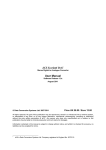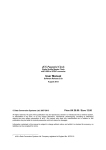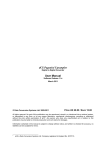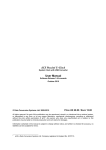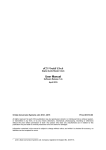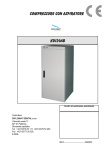Download Paganini Transport User Manual v1.0x
Transcript
dCS Paganini Transport Upsampling CD / SACD Transport User Manual Software Release 1.0x June 2010 © Data Conversion Systems Ltd. 2007-2010 Price UK £8.00 / Euro 12.00 All rights reserved. No part of this publication may be reproduced, stored in or introduced into a retrieval system, or transmitted in any form, or by any means (electronic, mechanical, photocopying, recording or otherwise) without the prior written permission of dCS 1 . Any person who does any unauthorised act in relation to this publication may be liable to criminal prosecution and civil claims for damages. Information contained in this manual is subject to change without notice, and whilst it is checked for accuracy, no liabilities can be accepted for errors. 1 dCS is Data Conversion Systems Ltd. Company registered in England No. 2072115. dCS Paganini Transport User Manual Filename: Paganini Transport Manual v1_0x BW.doc Software Issue 1.0x June 2010 Page 2 English version dCS Paganini Transport User Manual Software Issue 1.0x June 2010 Contents Using the dCS Paganini Transport for the first time ..............................................................................4 What’s in the box? Positioning the unit Safety Notice Which types of disc can be played? Which types of disc can NOT be played? Laser Radiation 4 4 5 6 6 6 Step-by-Step Guide ...............................................................................................................................7 Preliminaries Fitting the Remote Control handset batteries STEP 1 – Selecting a Digital Output STEP 2 – Choosing a Sync Mode Using the DAC in Master Mode Using a Master Clock STEP 3 – Playing a Disc STEP 4 – Other Features 7 8 9 10 10 11 12 12 Front Panel ...........................................................................................................................................13 POWER Button MENU Button JOG BACK Button JOG FORWARD Button STOP / EJECT Button PLAY / PAUSE Button Previous Track Button Next Track Button Remote Control Receiver Display CD Tray 13 13 13 13 13 14 14 14 14 14 14 Rear Panel ............................................................................................................................................15 Mains inlet Word Clock Input / Output PCM Outputs 1394 Interface SUC Connector 15 15 15 15 15 Remote Control....................................................................................................................................16 The Menu ..............................................................................................................................................17 Using the Menu INFORMATION Menu TRANSPORT SETTINGS Menu DISPLAY SETTINGS Menu SIGNAL GENERATOR Menu 18 19 20 20 21 Specification ........................................................................................................................................22 Maintenance and Support...................................................................................................................23 Service and Maintenance Replacing a Blown Mains Fuse Cleaning the case Limited Warranty If you need more help Software History Filename: Paganini Transport Manual v1_0x BW.doc Page 3 23 23 23 24 25 25 English version dCS Paganini Transport User Manual Software Issue 1.0x June 2010 USING THE dCS Paganini Transport FOR THE FIRST TIME Congratulations on purchasing your dCS Paganini Transport. Before using your unit, please read this section and the Step by Step Guide. This will enable you to set the unit up quickly and safely with your hi-fi system. From time to time, dCS will release updated software on CD that you can install yourself using the CD Update feature. Please check our web-site occasionally to see if new Paganini software is available, or consult your dealer. What’s in the box? Check that the box contains the following items: • • • • • • • • dCS Paganini Transport Manual and Menu / Setup Guide Power cable 1394 cable BNC cable 2 spare fuses Remote Control 2x AAA batteries Notify your dealer as soon as possible if anything is missing or damaged. We suggest that you retain the original packaging for possible future use. If this is not possible, replacement packaging can be ordered from dCS or our distributors. Details can be found on our web site at www.dcsltd.co.uk. The cables supplied are commercial-grade parts, as we realise our customers will want to make their own choices. Positioning the unit Units in the Paganini range may be stacked directly on top of each other, but are likely to give better sonic results when mounted on separate shelves of a rack. Place each unit on a firm, vibration free base, allowing convenient connection to the other parts of your system. To prevent overheating, we recommend that you leave some free space around the unit to allow for ventilation. 3 feet are fitted as standard, this may be changed to the 4-foot arrangement shown below, if you prefer. Spare feet are available as an optional extra. The mounting points are M4 size, maximum screw depth is 10mm. FRONT EDGE FRONT EDGE STANDARD 3-FOOT ARRANGEMENT OPTIONAL 4-FOOT ARRANGEMENT MOUNTING POINT FOR 4 FOOT ARRANGEMENT MOUNTING POINT FOR 4 FOOT ARRANGEMENT BACK EDGE Filename: Paganini Transport Manual v1_0x BW.doc MOUNTING POINT FOR 3 FOOT ARRANGEMENT BACK EDGE Page 4 English version dCS Paganini Transport User Manual Software Issue 1.0x June 2010 Safety Notice Your dCS Paganini Transport contains no user serviceable parts. DO NOT attempt to open the case as there are potentially dangerous voltages present inside. In the event of the unit developing a fault, please contact your dealer in the first instance. To maintain protection from electric shock, the unit MUST be connected to mains earth (ground) via the power cable. Also, unearthed systems do not give the best sonic performance. This product is lead-free to comply with the RoHS directive. Before connecting the power cable to the unit for the first time, please check that it has been set to the correct operating voltage for your mains supply. The unit’s voltage setting is shown on the serial number label. If this does not match your local supply voltage, DO NOT attempt to use the unit. Contact your dealer to have the unit reset. Using the unit with the wrong mains setting for your local supply may result in serious damage to the unit and will invalidate the warranty. Do not attempt to reset the voltage yourself. We do not recommend the use of mains regenerators. However, if you do wish to use a mains regenerator with variable voltage and frequency, we recommend that you set the voltage to match your local voltage and the frequency to either 50Hz or 60Hz ONLY. ! Damage caused to your Paganini Transport by misuse of a mains regenerator or by a malfunctioning mains regenerator is not covered by the warranty. Disposal at end-of-life - the symbol indicates that this product should not be treated as normal household waste. It should be recycled, so please take it to an approved collection facility. Filename: Paganini Transport Manual v1_0x BW.doc Page 5 English version dCS Paganini Transport User Manual Software Issue 1.0x June 2010 Which types of disc can be played? Commercially manufactured CDs can be played if they: • are 12cm or 8cm round discs • are recorded with linear PCM digital audio data • carry the Compact Disc Digital Audio logo and meet the “Red-Book” standard. Commercially manufactured single-layer SACDs or hybrid SACD/CD discs can be played if they: • are 12cm or 8cm round discs • are recorded with DSD digital audio data on the SACD layer • carry the Super Audio CD logo and so meet the “Scarlet-Book” standard. CD-R CD-RW CD-R or CD-RW discs recorded with audio data in CD format may be playable, but this depends on the disc, the software and the burner used to record on the disc. dCS cannot accept responsibility for any difficulty encountered while attempting to play such discs. Which types of disc can NOT be played? dCS cannot accept responsibility for any difficulty encountered while attempting to play the following types of disc: • Scratched, damaged or dirty discs. • Printed or labelled CD-Rs or discs contaminated with glue or other sticky substances. These may get stuck inside the unit. If this happens, the warranty on the Transport will be void. A service charge will be made for removing such discs. • DVD, CD-G, CD-EXTRA, PHOTO CD, CD-ROM or DVD-ROM. • Copy-protected discs that do not conform to the “Red-Book” CD standard may not play correctly or may not play at all. Such discs are not CDs – they are optical discs that have been recorded with digital audio data. They should not carry the Compact Disc Digital Audio logo – but some do. If you encounter any difficulty playing such discs, please contact the disc manufacturer and demand a genuine CD in exchange. Laser Radiation dCS Paganini Transport is a Class 1 Laser Product, it complies with U.S. FDA 21CFR subchapter J. In normal use, there is no risk of exposure to laser radiation. ! The case should only be opened by authorised service personnel. The case protects the user from indirect exposure to visible and invisible laser radiation, as well as risk of electric shock. Filename: Paganini Transport Manual v1_0x BW.doc Page 6 English version dCS Paganini Transport User Manual Software Issue 1.0x June 2010 STEP-BY-STEP GUIDE This section guides you through setting up the unit for basic operation. Preliminaries The Menu / Setup Guide sheet details the menu structure and details the two most common set-ups. For digital interfaces, use with cables designed for digital audio: • for AES/EBU interfaces use 110Ω screened, twisted pair cables fitted with one male XLR connector and one female XLR connector. • for Word Clock interfaces, use 75Ω coax cables fitted with BNC plugs. • for SPDIF RCA interfaces, use 75Ω coax cables fitted with RCA Phono plugs. • for IEEE 1394 interfaces, use the IEEE 1394 cable provided with the unit. Switch on the rest of the system first. Connect the power cable supplied to the power inlet on the rear panel, plug the other end into a convenient power outlet. ! Please do not use an excessively heavy or inflexible power cable as this may damage the power inlet connector. Set the rear panel power switch to the I position. Briefly press the Power button and wait about 30 seconds while the Transport configures itself. The display will show in sequence: Paganini Transport and No Disc. If the unit is likely to be set in an unfamiliar state, you can reset it as follows. Press the Menu button, press the → button once, then the Menu button again to display the Transport Settings menu. Press the ← button repeatedly to highlight the Factory Reset menu page. Press the Menu button and wait a few seconds while the settings are reset. Filename: Paganini Transport Manual v1_0x BW.doc Page 7 English version dCS Paganini Transport User Manual Software Issue 1.0x June 2010 Fitting the Remote Control handset batteries Use a small coin to release the screw securing the back plate. ! Lift the screw a little and slide the back plate off. Fit 2 AA size batteries by pressing the flat end (-) against the spring and pressing the battery into the slot, so that the + end makes contact with the stud. Slide the back plate into place and tighten the screw. Failure to fit the batteries correctly can damage your Remote Control. Such damage is not covered by the warranty. Please dispose of used batteries properly at a waste disposal site, not in the household waste. Filename: Paganini Transport Manual v1_0x BW.doc Page 8 English version dCS Paganini Transport User Manual Software Issue 1.0x June 2010 STEP 1 – Selecting a Digital Output Whether you are playing a CD or an SACD, the 1394 interface carries DSD data and all of the PCM outputs carry CD-format data. Most owners connect the 1394 interface only, but some prefer to listen to CDs in the native 16 bit 44.1kS/s format. Connecting the IEEE 1394 interface • Connect one 1394 output on the Transport to one 1394 input on the DAC. Also connect the W/Clk Out on the Transport to the W/Clk In connector on the DAC. • Press the DAC Input button repeatedly until 1394 or dCS PTT is displayed. The DAC may display Wait ..., No-WClk or Search.., messages if the unit is still settling, then in sequence (Clk OK), Locking and No Audio. If you have more than one source connected to the 1394 bus, it may be necessary to use the Input button to select the 1394 source you want to listen to. If the EasyPlay menu is set to Full, inserting a disc in the Transport will switch the DAC to the 1394 input. Transport dCS Model: Paganini Transport PCM OUTPUTS 1394 ~ 50/60 Hz, 50W SUC Class 1 Laser Product W/CLK IN RCA 1 W/CLK OUT RCA 2 AES 1 AES 2 Fuse T 500mA L DAC dCS Model: Paganini DAC ANALOGUE OUTPUTS DIGITAL INPUTS 1394 RCA 1 ~ 50/60 Hz, 50W LEFT W/CLK IN AES 1 AES 2 PUSH PUSH SUC RCA 2 LEFT W/CLK OUT RIGHT RIGHT Fuse T 500mA L L R R L Balanced & Unbalanced Analogue Outputs Figure 1 – Basic setup Connecting a Single AES or RCA output • Connect one of the outputs on the Transport to the matching input on the DAC using a suitable cable. • Press the DAC Input button repeatedly until your chosen input is displayed. This will be either AES1, AES2, RCA1 or RCA2. The DAC will lock to the source, displaying in sequence (44.1k), Locking, 16/44.1. Proceed to Step 2. Filename: Paganini Transport Manual v1_0x BW.doc Page 9 English version dCS Paganini Transport User Manual Software Issue 1.0x June 2010 STEP 2 – Choosing a Sync Mode So far, the system has been set up to lock to the clock generated by the source. If you are using the 1394 or SDIF interfaces, the DAC will lock to a word clock generated by the Transport. This is the simplest arrangement, but it does not give the best sonic performance due to clock jitter. Using the DAC in Master Mode If you have a Paganini Clock, go to the next page. You can reduce the jitter in your system by using the Paganini DAC in Master mode and slaving the Transport to it. Transport dCS Model: Paganini Transport PCM OUTPUTS 1394 ~ 50/60 Hz, 50W SUC Class 1 Laser Product W/CLK IN RCA 1 W/CLK OUT RCA 2 AES 1 AES 2 Fuse T 500mA L DAC dCS Model: Paganini DAC ANALOGUE OUTPUTS DIGITAL INPUTS 1394 RCA 1 ~ 50/60 Hz, 50W LEFT W/CLK IN AES 1 AES 2 PUSH PUSH SUC RCA 2 LEFT W/CLK OUT RIGHT RIGHT Fuse T 500mA L L R R L Balanced & Unbalanced Analogue Outputs Figure 2 – Using the Paganini Transport with the DAC in Master Mode • Use the DAC’s Input button to select the input you want to use. • Connect the DAC’s W/Clk Out connector to the Transport’s W/Clk In connector. • Press the Sync button to set the DAC to Master mode and allow the system to re-lock. Filename: Paganini Transport Manual v1_0x BW.doc Page 10 English version dCS Paganini Transport User Manual Software Issue 1.0x June 2010 Using a Master Clock The performance can be improved further by adding a Paganini Clock to the system as shown below. Transport dCS Model: Paganini Transport PCM OUTPUTS 1394 ~ 50/60 Hz, 50W SUC Class 1 Laser Product W/CLK IN RCA 1 W/CLK OUT RCA 2 AES 1 AES 2 Fuse T 500mA L Clock dCS Model: Paganini System Master Clock W/CLK OUT 2 3 ~ 50/60 Hz, 50W 1 SUC SPDIF IN 6 5 4 Fuse T 500mA L DAC dCS Model: Paganini DAC ANALOGUE OUTPUTS DIGITAL INPUTS 1394 RCA 1 ~ 50/60 Hz, 50W LEFT W/CLK IN AES 1 AES 2 PUSH PUSH SUC RCA 2 LEFT W/CLK OUT RIGHT RIGHT Fuse T 500mA L L R R L Balanced & Unbalanced Analogue Outputs Figure 3 – Using the Paganini Transport, DAC and Clock together • • • • Use the DAC’s Input button to select the input you want to use. Connect two of the Clock’s W/Clk Outputs to the W/Clk Inputs of the Transport and DAC. Use the Clock’s Frequency button to set the outputs to 44.1kHz, to suit the Transport. Use the DAC’s Sync button to set the DAC to WClk mode and allow the system to re-lock. Please consult the Clock manual for more information on using a Master Clock. Proceed to Step 3. Filename: Paganini Transport Manual v1_0x BW.doc Page 11 English version dCS Paganini Transport User Manual Software Issue 1.0x June 2010 STEP 3 – Playing a Disc • Press the button. The display will show OPEN. • Load a CD or SACD into the tray with the label upwards and either push the tray in gently or press the button again. The display will show CLOSE, then LOADING. The disc type will be identified, either CD or SACD appears on the display, along with the number of tracks and the total playing time. The Transport will play the SACD layer of a hybrid disc by default, but you can select the CD layer instead using the menu. • Press the button to start the disc playing. Turn up the Volume to a comfortable level. You should have audio. For all discs, the disc type and elapsed time will be displayed. • Press the • Press the • Press the button to pause playing, press again to resume playing. or button to skip to the next track or the previous track. or button to jog through the track. To go faster, press the button again (speed 2) and again (speed 3). Press the • Press the button to return to play mode. button to stop the disc. Press it again to open the tray. STEP 4 – Other Features The Remote Control gives access to other features, such as track number selection, repeat track or disc and programming a track sequence. To select track 5 as an example, either press button 5 and wait a few seconds or press 0 then 5 within the next few seconds (this is quicker). To select track 12, press 1 then 2. Press the Repeat button repeatedly to cycle through the options: • Repeat Track - repeat the track that is currently playing. • Repeat Disc - repeat the whole disc. • Repeat Off – normal operation. With the disc stopped, press the Program button to program a track sequence, next select the track numbers you want to play in any order. We suggest entering 2 digits for each track number, as this will allow you to enter the sequence more quickly. For example, pressing Program 05 04 06 Play will play track 5, then track 4, then track 6 and stop. The unit will display 6PGM3, where 6 is the last track number entered and 3 is the number of tracks in the sequence. Press Clear to remove the last track from the sequence (track 6), the display will change to 4PGM2. Press Program again to cancel program mode, the unit will display Program Off. Opening the CD tray also cancels program mode. The next step is crucial – sit back and enjoy the music. When you have finished listening, you can either keep the system warm by setting it to Sleep mode (press the Power button briefly) or switch off (hold down the Power button until Power Down is displayed, then release). Filename: Paganini Transport Manual v1_0x BW.doc Page 12 English version dCS Paganini Transport User Manual Software Issue 1.0x June 2010 FRONT PANEL A B C D L paganini POWER MENU dCS E F G H K M N Figure 4 – Front panel POWER Button To switch on, ensure the rear panel switch is set to I and press the POWER button (A) on the front panel once. Note that the unit cannot be turned on from the remote control. To set the unit to sleep mode, press the POWER button once. The main display will turn off, the LED to the left of the button will illuminate, and the outputs will mute, but the unit will remain close to running temperature. Press again to return to normal operation. To switch off, hold down the POWER button for about 5 seconds until Power Down appears on the display, then release it. When the menu is open, press the POWER button to close the menu. MENU Button Press the MENU button (B) to open the menu, select menu pages and change settings. See the Menu section on page 17 for information on using the menu features. JOG BACK Button When a disc is playing, press this button (C) to jog back through the current track. Press again to jog faster (speed 2), press again to jog faster still (speed 3). Pressing this button a fourth time returns to PLAY mode. Jogging past the start of track 1 returns to PLAY mode. JOG FORWARD Button When a disc is playing, press this button (D) to jog forward through the current track. Press again to jog faster (speed 2), press again to jog faster still (speed 3). Pressing this button a fourth time returns to PLAY mode. Jogging to the end of the disc stops the transport. STOP / EJECT Button Press the STOP / EJECT button (E) to stop playing a disc. Press again to open the CD tray. Press again to close the CD tray. When the menu is open, the STOP / EJECT button changes to the < button, used to page backwards through the menu. Filename: Paganini Transport Manual v1_0x BW.doc Page 13 English version dCS Paganini Transport User Manual Software Issue 1.0x June 2010 PLAY / PAUSE Button After a disc has been read, press the PLAY / PAUSE button (F) to start playing. Press again to pause and again to resume playing. When the menu is open, the PLAY / PAUSE button changes to the > button, used to page forwards through the menu. Previous Track Button Press this button (G) to skip to the previous track, or to the start of the current track if the disc is playing. This feature is easier to use when the disc is stopped or paused. Next Track Button Press this button (H) to skip to the next track. Skipping past the last track returns to track 1. Remote Control Receiver Aim the remote control handset towards the receiver (K) for best sensitivity. Display In normal use, the display (M) is split into 5 areas: When stopped, the number of tracks on the disc is shown. When playing or paused, the current track number is shown. 20 SACD Disc type or hybrid disc layer: SACD or CD Track or disc time (hours, minutes, seconds) 01:19:21 Total elapsed time or Total remaining time or Track elapsed time or Track remaining time Track Elapsed This symbol indicates the mechanism status: Stop, Play, Pause, Fast Reverse, Fast Forward, Open or Close. Sync will also appear here when the transport is locked to an external clock. While locking is in progress, Sync will appear greyed out. If a clock is present but the Transport cannot lock to it, ?Sync? will be displayed and the Transport will use its own clock. If a track sequence has been set up, PGM will appear here. Details of the menu displays are shown in the Menu section on page 17. If the display is turned off on the Display Settings / Display Off menu page, the LED (L) above the display illuminates. CD Tray When loading a CD or SACD into the CD tray (N), ensure the disc is central with the label upwards and is seated correctly. Filename: Paganini Transport Manual v1_0x BW.doc Page 14 English version dCS Paganini Transport User Manual Software Issue 1.0x June 2010 REAR PANEL P T dCS Model: Paganini Transport PCM OUTPUTS 1394 ~ 50/60 Hz, 50W SUC Class 1 Laser Product W/CLK IN RCA 1 W/CLK OUT RCA 2 AES 1 AES 2 Fuse T 500mA L O Q U V W X Y Figure 5 - Rear Panel Mains inlet Power is connected via a standard IEC320 connector (P), protected by a fuse (Q) and isolated by a 2pole power switch (O). Word Clock Input / Output The W/Clk In connector (T) will accept standard 44.1kHz word clock from DAC in master mode or a master clock. Sync will appear on the display when the transport is locked to the external clock. Sync will appear greyed out for a few seconds during locking. If activity is detected but the Transport cannot lock to the clock signal (for example, because it is at the wrong frequency or level), ?Sync? is displayed and the Transport uses its own clock. The W/Clk Out connector (U) carries a 44.1kHz word clock. Word clock is used for synchronisation only, it does not carry digital data. PCM Outputs The unit features 2 co-ax SPDIF outputs on RCA phono connectors, RCA1 & RCA2 (V), and 2 AES/EBU outputs on 3-pin XLR connectors, AES1 & AES2 (W). These outputs carry CD format data (16 bits at 44.1kS/s), either direct when playing a CD or down-sampled when playing an SACD. 1394 Interface The IEEE 1394 interface (X) outputs encrypted DSD data. 1394 interfaces are great for carrying lots of digital data - but are very poor at transmitting a stable clock, so a separate Word Clock connection is required. The two 1394 ports are identical – they can be used as data outputs or as a loop-through. Note that the 1394 bus must not be connected in a loop as this will prevent the system initialising. SUC Connector The SUC connector (Y) is an RS232 interface, primarily used to remotely control the unit during automated testing. Please contact dCS for advice on using this interface with a household automation system. Note that we recommend using infra-red remote control instead. Filename: Paganini Transport Manual v1_0x BW.doc Page 15 English version dCS Paganini Transport User Manual Software Issue 1.0x June 2010 REMOTE CONTROL The upper section of the Remote Control is mainly for the DAC, the lower section is for the Transport. Hold down the Sleep button for 2 seconds to set the system to sleep mode. Press the Sleep button again to return to normal operation. In Sleep mode, press the OFF button to turn the system off. The Upsampler Input button selects the input. The Upsampler Output button selects the output sample rate. The Filter button changes the DAC filter setting. The Balance button toggles the DAC between Volume and Balance adjustment modes. The AES button selects the DAC’s AES input, the 1394 button selects the DAC’s 1394 input. The Input + and Input – buttons cycle through the available inputs. The Vol+ and Vol– buttons adjust the DAC’s Volume / Balance. Mute turns the DAC’s outputs off and on. The Program and Clear buttons are used with the 0 – 9 buttons to set or change a track sequence for the loaded disc. The 0 – 9 buttons select the current track. Pressing 5 or 05 will select track 5. The Stop/Eject, Play/Pause, Previous Track, Next Track, Jog Back and Jog Forward buttons operate in the same way as those on the Transport front panel. The Repeat button cycles through Repeat 1 (repeat the current track), Repeat (repeat the whole disc) and Repeat Off. The Display button changes the time displayed on the Transport, cycling through Track Elapsed, Track Remaining, Disc Elapsed and Disc Remaining. When the system is completely off (not just in sleep mode), press the front panel Power buttons to turn it on. You cannot use the Remote Control for this. The OFF button will only operate if the system is in sleep mode. If you have more than one 1394 source connected, the Remote’s 1394 button will select the first source. Use the Remote’s Input + button to select other sources. Filename: Paganini Transport Manual v1_0x BW.doc Page 16 English version dCS Paganini Transport User Manual Software Issue 1.0x June 2010 THE MENU Press "Step >" to move along the Menu, press "< Step" to move back. Press "Menu" to set a menu option or change options. MENU Information Transport Settings Display Settings Version Contact Unit information CDUpdate Displays the loaded software issues and serial number Displays dCS contact details Displays the unit status Starts software update from a dCS CD Layer Easy Play Factory Reset Selects format for playing hybrid discs Sets the mode of the automatic input switching Restores standard factory settings Bright Contrast Test Display Display Sets the display brightness Adjusts the display contrast. Runs a display test routine Turns the main display on/off . Press -> to increase, press <- to reduce. Signal Generator Transport ONLY Channel Check Phase Check Outputs tone on L channel only then R channel only Outputs noise on both channels then inverts R Figure 6 – The menu sequence Filename: Paganini Transport Manual v1_0x BW.doc Page 17 English version dCS Paganini Transport User Manual Software Issue 1.0x June 2010 Using the Menu The menu gives the user access to a range of additional features. It also allows new features and performance enhancements to be added at a later date by software upgrades. The menu is controlled by four buttons. Press the MENU button to open the menu or select a setting. Press the > button to page forward through the menu. Press the < button to page backward through the menu. Press the POWER button to close the menu or just wait 5 seconds. Use the Menu Guide sheet to help you find the right menu. Each unit in the range has either three or four top-level menu pages: The INFORMATION menu gives software issues, serial number, contact details and unit set-up details. The SETTINGS menu allows you to set some features that are not directly accessible from the front panel. The DISPLAY SETTINGS menu is used to adjust and test the display. The SIGNAL GENERATOR menu is used to check the system during set-up. Use the > button to move the highlight to the menu you want, then press the MENU button to select it. The next menu level down is displayed. Use the > button to move the highlight to the menu page you want, then press the MENU button to display the information or change the setting. Select the exit icon to go back to the previous menu level. Filename: Paganini Transport Manual v1_0x BW.doc Page 18 English version dCS Paganini Transport User Manual Software Issue 1.0x June 2010 INFORMATION Menu The Version page displays the software versions loaded in the unit and the full serial number. Please have this information ready if you contact your dealer for any reason. The Contact page displays dCS web-site URL, email address, telephone and fax numbers. If you have any difficulty, please contact your dealer for help first. The Transport Information page displays the unit status: • • • • • Area: No Disc / CD / SACD WClk In: Inactive / 44.1kHz I/F version: x.xx B/E version: x.xx F/E version: x.xx Use the < and > buttons to scroll down the list and press the MENU button to exit. The CD Update feature allows you to load new software into your Paganini Transport. Please follow the instructions supplied with the update CD carefully. While playing an SACD, CD Updating is not possible and the icon will be greyed out. Use the front panel controls during an update as the remote control may not operate. ! If you accidentally start a CD Update, switch off the unit at the back panel switch, wait 10 seconds, then switch on again. Filename: Paganini Transport Manual v1_0x BW.doc Page 19 English version dCS Paganini Transport User Manual Software Issue 1.0x June 2010 TRANSPORT SETTINGS Menu When playing a hybrid disc, the Layer page allows you to select either the CD or SACD layer. The active layer will be shown as dark, the other layer will be greyed out. While changing layers and re-reading the disc, Please wait... is displayed. The EasyPlay system automatically selects the right DAC input to suit the type of disc being played. The EasyPlay system requires that the DAC is locked to a source when the disc is loaded and a direct 1394 connection between Transport & DAC. The Transport examines the interconnections between units then stores a setup for CD and a setup for SACD. There are 3 options: • EasyPlay Off disables the automatic switching. You will need to set the DAC input to match the type of disc being played. • EasyPlay Full sets the DAC to the 1394#0 input (Transport channel), whether a CD or SACD is played. • EasyPlay SACD sets the DAC to the 1394#0 input when an SACD is played. When a CD is played, the system sets the DAC to the input that is sourced from the Transport, either directly or via an Upsampler. If there is more than one route between the 2 units (ignoring the direct 1394#0 connection) the input is selected in this order of priority: 1394#1 (Upsampler channel), Dual AES (via Upsampler), AES1, AES2, RCA1, RCA2. (Selection of the Upsampler’s 1394 channel requires DAC software issue 1.10 or later). The Factory Reset menu page resets the unit to standard settings. These are: Hybrid Layer to SACD. Easy Play to Full. Display to On. Brightness to maximum. Contrast to 60%. Programmed sequences cleared. Repeat to Off. DISPLAY SETTINGS Menu Set the display Brightness to a comfortable level using the < and > buttons. Set the display Contrast to a comfortable level using the < and > buttons. Runs a Display Test routine, which flashes all the indicators and the main display. Display On / Off. Filename: Paganini Transport Manual v1_0x BW.doc Page 20 English version dCS Paganini Transport User Manual Software Issue 1.0x June 2010 SIGNAL GENERATOR Menu Use the Channel Check routine to test the system for swapped channels. A tone is output on the left channel only while the display shows Left, then the right channel only while the display shows Right. If the these are the wrong way around, the left and right channels are swapped somewhere in your system. Use the Phase Check routine to test the system for phase reversals. Noise is output in phase on both channels while the display shows In Phase. Press the MENU button, the noise on the right channel is inverted while the display shows Out of Phase. The first burst should produce a central image, the second burst should not. If these are the wrong way around, one channel in your system is phase inverted. Press the < or > button to stop the test and return to the menu. Filename: Paganini Transport Manual v1_0x BW.doc Page 21 English version dCS Paganini Transport User Manual Software Issue 1.0x June 2010 SPECIFICATION Mechanism type Dual laser CD/SACD mechanism. Digital outputs IEEE 1394 interface on 2x 6-way connectors. The interface outputs dCSencrypted DSD (1 bit data at 2.822MS/s), whether a CD or SACD is playing. 2x AES/EBU on 3-pin male XLR connectors. Both output CD format data (16 bits at 44.1kS/s), whether a CD or SACD is playing. 2x SPDIF on 1x RCA Phono. Both output CD format data, whether a CD or SACD is playing. Clocking Word Clock Output on 1x BNC connector. With the transport in Master mode, a TTL-compatible 44.1kHz word clock derived from the internal crystal oscillator is available on this output. The calibration accuracy when shipped is +/-10ppm, not temperature compensated. Calibration usually remains stable for several years, but this is not guaranteed. Word Clock Input on 1x BNC connector, accepts standard word clock at 44.1kHz. Sensitive to TTL levels, input impedance is 75Ω. Size and weight 460mm (18.1“) W x 400mm (15.8“) D x 110mm (4.4“) H including feet. Allow extra depth for cable connectors. Allow space for air flow around the unit. Weight 11.5kg (25.3lbs). Power requirements Internally set to either 100, 115/120, 220 or 230/240V AC, 49 – 62Hz. Power consumption: 20W typical, 30W maximum. These specifications are subject to change without notice. Filename: Paganini Transport Manual v1_0x BW.doc Page 22 English version dCS Paganini Transport User Manual Software Issue 1.0x June 2010 MAINTENANCE AND SUPPORT Service and Maintenance dCS audio products are designed not to need regular maintenance, and contain no user serviceable parts apart from the mains fuse. If your unit is damaged in any way, please contact your dealer. Replacing a Blown Mains Fuse There is a mains fuse below the power inlet, accessible from the outside of the unit. If the fuse blows, it may be changed by the user. The current consumption of the unit is very low, so it only blows if power surges occur, or there is a fault in the unit. Usually power surges cause no other damage, but if the fuse blows repeatedly on replacement, some other damage will have been done and the unit will need to be repaired. Fuse type: 20mm x 5mm T0.5 amp L fuse ! If the fuse should fail, it is essential that it is replaced with one of the same type and rating. Failure to do so could result in damage to the unit, risk of fire or electric shock and will invalidate the warranty. Referring to the diagram below, remove the power cable, use a small flat bladed screwdriver to pry up the tab on the fuse carrier (A) and pull it out. Push the blown fuse out of the clip in the carrier (B) and dispose of it. Fit a new fuse in the clip (C) and push the carrier back into the unit so that it clicks home. Spare fuses are provided with the unit. B A C Cleaning the case The front panel of your dCS equipment is machined from very high grade aluminium. Great care has been taken to create the finish of the aluminium throughout the engineering process from the raw solid material to the finished piece. To remove loose dust or finger marks from the case, we recommend that you use a clean, dry, lintfree cloth. To restore the finish on the front panel, we recommend applying small quantities of a lanolin based cleaner, using a clean, dry, lint-free cloth and then wiping off. Do not allow lanolin to collect around the buttons. Small amounts of glass cleaner containing ammonia may be used to clean other surfaces, but avoid spraying onto the connector contacts. Filename: Paganini Transport Manual v1_0x BW.doc Page 23 English version dCS Paganini Transport User Manual Software Issue 1.0x June 2010 Limited Warranty General dCS warrants this product against defects in materials and workmanship for a period of 3 years from the date the unit was originally shipped from dCS. During the warranty period, dCS will repair or, at our absolute discretion, replace a faulty product. Warranty repairs must only be carried out by dCS or our authorised service agents. Please contact your dealer if your unit requires service. Your dealer should have completed on your behalf an Owner Registration form at the time of sale and returned it to dCS. On receipt of the Owner Registration form, dCS will add your contact details to our customer database. dCS will use this information for warranty purposes only, we will not contact you directly for reasons relating to sales and marketing. This warranty applies to the original owner. Warranty Exclusions The Warranty does not cover wear and tear. The Warranty on this product will be void if: • the product is misused in any way. • any unauthorised modifications or repairs are carried out. • the product is not used in accordance with the Operating Conditions stated in this manual. • the product is serviced or repaired other than by dCS or our authorised service agents. • the product is operated without a mains earth (or ground) connection. • the unit is returned inadequately packed. dCS reserve the right to apply a service charge if a product returned for warranty repair is found to be operating correctly, or if a product is returned without a returns number being issued. This warranty covers parts and labour only, it does not cover shipping charges or tax/duty. Our dealers or distributors are NOT authorised to extend the terms of this warranty, dCS cannot accept responsibility for any attempt to do so. Products re-sold by dCS on a “used” basis may be subject to reduced warranty terms. Obtaining Service Should you encounter a problem, contact your authorised dCS dealer for advice, quoting the model, the full serial number, software version number, and giving a detailed description of the fault. Your dealer will advise you fully on actions that need to be taken. When returning a unit, the original packaging should be used to avoid transit damage. Replacement packaging sets may be purchased from dCS. During the Warranty period, there will normally be no charge for parts or labour. Operating Conditions • • • • • The supply voltage must remain within +/-10% of the A.C. voltage specified on the back panel. The supply frequency must be in the range 49Hz to 62Hz. Ambient temperature range: 0°C (32°F) to 40°C (104°F), non-condensing. Do not install the unit near heat sources such as radiators, air ducts, power amplifiers or direct strong sunlight. If in doubt, the easy test is – the unit is happy to work anywhere a human is. Filename: Paganini Transport Manual v1_0x BW.doc Page 24 English version dCS Paganini Transport User Manual Software Issue 1.0x June 2010 If you need more help In the first instance, you should contact your dealer. If they cannot resolve the issue, contact your national distributor. Manufactured by: Data Conversion Systems Ltd. Unit 1, Buckingway Business Park, Anderson Road, Swavesey, Cambridge. CB24 4AE UK www.dcsltd.co.uk This user manual may be downloaded free of charge from our web-site. A bound copy of this manual may be ordered from dCS. Software History dCS products make extensive use of software configurable chips – FPGAs and DSPs. This gives us the ability to update our products to add extra features, update digital interface standards or make performance improvements by loading new software. Occasionally, a hardware upgrade may be necessary also to increase the “capacity” of the electronics, add extra connectors or extra front panel controls. Please note that not all software updates make an earth-shattering change. You should have a clear idea of what you expect to gain before updating to the latest issue. We recommend that you keep your software up to date. Check the dCS web-site for the latest software updates. This manual is for Paganini Transport software version 1.0x. Issue 1.00 - The first issue, with 1394 issue 3.00. Issue 1.02 – Bug fixes to improve reliability. Filename: Paganini Transport Manual v1_0x BW.doc Page 25 English version

























